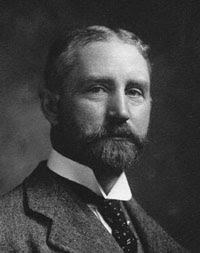During the first 35 years of its existence, the Massachusetts Institute of Technology was headed by its founder, William Barton Rogers, former Civil War General Francis A. Walker, and two MIT professors. The selection of Henry Smith Pritchett to become the Institute's fifth president in 1900 signaled a shift in direction.
Pritchett held a doctorate in astronomy from the University of Munich and had demonstrated both his academic and administrative strengths. He had spent 17 years in academia, and three years in an impressive stint as superintendent of the US Coast and Geodetic Survey where he developed a close relationship with President McKinley. He was young, bright, energetic, well-connected, handsome, socially adept, and popular, and he arrived at MIT in the summer of 1900 with high hopes for his future there.
Despite his achievements at MIT, Pritchett's career as a college president ended up being a brief six years in duration. In 1904, Pritchett proposed what was essentially a loose merger between Harvard and MIT. Under this plan, Harvard's Lawrence Scientific School would become part of the Institute, the Institute would move to Cambridge under the aegis of Harvard (on the site currently occupied by the Harvard Business School), and Pritchett would retain the presidency and a certain amount of independence for the Institute. MIT alumni and faculty were largely opposed, but the real fly in the ointment was the unwillingness of the Massachusetts legislature to allow the sale of Tech's Boston property on Boylston Street. Pritchett resigned the presidency of MIT after the deal fell through, and left Boston in 1906 to head the brand new Carnegie Foundation for the Advancement of Teaching.
Pritchett is largely a forgotten man in Boston and Cambridge but his influence on education and educators in this mecca of US education was enormous.
MIT
His first achievement was his work at MIT. Dr. Robert Payne Bigelow, a professor there from 1893-1933, says that Pritchett's administration was "a turning point in the history of the Institute."
Pritchett’s primary concern was for student welfare—academic, social, and physical. He encouraged students to seek advice from him, he established a department of physical education, he turned the culture on its head by having top faculty teach freshmen, he cultivated relations with the staff and increased their salaries, he sent professors to visit laboratories abroad, and he developed the departments of chemical engineering and applied electricity. Bigelow goes on: “I have naturally watched with much interest its growth from the turning point under Pritchett to the magnificent institution it is today. I have seen practically all of Pritchett’s dreams come true.”
Franklin Union
Pritchett was a great supporter of other forms of industrial education. In 1904, as a trustee of Boston's Franklin Foundation (the accumulated value of a thousand pound legacy bequeathed to the city by Benjamin Franklin), he was instrumental in getting Andrew Carnegie to match the $408,000 then in the fund. This created a large enough endowment to found an evening training school to be called the Franklin Union. The conditions attached to Carnegie's gift were two: that the school be similar to the Cooper Union and NYC's Mechanics' and Tradesmen's School, and that the City of Boston provide the land. Both conidtions were met, and the school opened in its new building in Boston in the fall of 1908.
Today the Franklin Union has become the
Benjamin Franklin Institute of Technology, offering nine associate's degrees in engineering and industrial technology, a bachelor's degree in automotive technology, and a variety of certificate programs.
Lowell Institute
During Pritchett's tenure as MIT president, he was asked by Abbott Lawrence Lowell, a Harvard professor (and later to be Harvard president), MIT trustee, and trustee of the Lowell Institute to find a man who could plan and conduct courses aimed at training industrial foremen. The Lowell Institute had grown out of a bequest by Lowell's grandfather, textile merchant John Lowell, to offer what were to become hugely popular free public lectures to the citizens of Boston. The new undertaking would be a joint venture by the Lowell Institute and MIT. Pritchett selected Dr. Charles F. Park to be the director of the Lowell Institute School for Industrial Foremen, a move to which Lowell credited the successful launch of the new school. Since 1996, the
Lowell Institute School has been a part of the Northeastern University College of Professional Studies, offering bachelor's and associate degrees in engineering technologies.
TIAA-CREF
Pritchett's final contribution, this time to educators, was not limited to the Boston area. As President of the brand new Carnegie Foundation for the Advancement of Teaching, he was charged with developing a plan to provide pensions for retired faculty members. The Trustees had originally hoped to fund free pensions but it became apparent to them that the endowment was not large enough for this purpose. Pritchett proposed a pension fund partly funded by the institutions and the faculty members themselves. This was named the Teachers Insurance and Annuity Association (now better known as part of TIAA-CREF), and Pritchett served as its President from 1918-1930. (TIAA-CREF today holds over $450 billion in assets.)
NOTE: The Lowell Institute was also the founder of Boston's public radio/TV station WGBH in 1951. In 1946, the Institute had begun broadcasting its lectures on the radio, and the Lowell Institute Cooperative Broadcasting Council was the licensee for one of the newly created FM radio channels in April 1951.
Illustration Credits and References
Photo of Henry S. Pritchett from the
MIT History website.
1903 photo of the Boylston street MIT campus from
Hello Boston History Photo Archive.
Information about Henry Pritchett's career largely obtained from
Henry S. Pritchett: A Biography by Abraham Flexner, New York: Columbia University Press, 1943.






